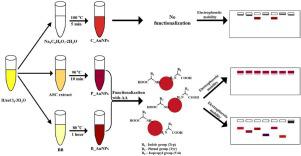Particuology ( IF 3.5 ) Pub Date : 2020-02-22 , DOI: 10.1016/j.partic.2019.12.010 Darshana V. Havaldar , Reshma V. Patil , Disha N. Moholkar , Priyanka S. Magdum , Akash P. Vadrale , Kiran D. Pawar

|
The potential utility of gold nanoparticles (AuNPs) synthesized via different methods for biomedical applications vary greatly due to inherent differences in their surface properties. In the present study, we investigated the functionalization of AuNPs synthesized by chemical reduction, plant extract, and bacteria-mediated methods with 22 l-amino acids. Nanoparticles produced by bacteria-mediated (B_AuNPs) and plant-mediated (P_AuNPs) methods showed good potential, as they were able to be functionalized with six (histidine, lysine, methionine, phenylalanine, tryptophan, and tyrosine) and four (cystine, tryptophan, tyrosine, and valine) amino acids, respectively. In contrast, AuNPs produced by chemical reduction (C_AuNPs) were not found to be suitable for functionalization. Optimal functionalization conditions were found to be amino acid concentration of 20–25 mM and neutral pH (7) for P_AuNPs, whereas B_AuNPs tolerated more variable conditions. The electrophoretic mobility of P_AuNPs after functionalization indicated that these nanoparticles were less sensitive than B_AuNPs to the deviations from optimal conditions. A significant change in mobility was observed when B_AuNPs were functionalized with either methionine or tryptophan. Overall, the results of this study suggest that the suitability of the three differently synthesized AuNPs with amino acids is in the following order: B_AuNPs > P_AuNPs > C_AuNPs.
中文翻译:

不同合成的金纳米颗粒对L-氨基酸的功能化反应不同
通过不同方法合成的金纳米颗粒(AuNPs)在生物医学应用中的潜在效用因其表面性质的内在差异而大大不同。在本研究中,我们研究了通过22升化学还原,植物提取物和细菌介导的方法合成的AuNP的功能化-氨基酸。通过细菌介导的(B_AuNPs)和植物介导的(P_AuNPs)方法生产的纳米颗粒具有良好的潜力,因为它们可以被六个(组氨酸,赖氨酸,蛋氨酸,苯丙氨酸,色氨酸和酪氨酸)和四个(胱氨酸,色氨酸)功能化。 ,酪氨酸和缬氨酸)氨基酸。相反,未发现通过化学还原产生的AuNPs(C_AuNPs)适合于功能化。最佳功能化条件被发现是P_AuNPs的氨基酸浓度为20–25 mM,pH为中性(7),而B_AuNPs耐受更多的条件。功能化后P_AuNPs的电泳迁移率表明,这些纳米颗粒对B_AuNPs偏离最佳条件的敏感性较弱。当B_AuNPs被甲硫氨酸或色氨酸官能化时,观察到了迁移率的显着变化。总体而言,这项研究的结果表明,三种不同合成的具有氨基酸的AuNPs的适用性按以下顺序排列:B_AuNPs> P_AuNPs> C_AuNPs。


























 京公网安备 11010802027423号
京公网安备 11010802027423号